
19 minute read
6XX Chefs
The RLC Chef Ethos Project
By WO1 Ashley Johnson, DCWO 6th (UK) Division
The RLC Chef is the only soldier who has three deadlines every day, to ensure mission success is achieved.
This statement might raise an eyebrow but being an RLC chef is a tough business. The famous Napoleon quote: “An Army marches on its stomach,” has stood the test of time because of what food offers. Good food gives more than the nutrients needed to maintain life. It transports us to our childhood through smells and flavours, it offers a space for us to laugh and build relationships and above all it gives us respite when we are having a tough day. Chefs are positioned throughout the Army, bouncing from unit to unit, working in small teams and having to adapt quickly to the nuances of these different groups. Because of this, our identity and belonging has become muddled, nevertheless our passion and pride remains the same.
Developing an ethos, is like delving into your soul. Understanding what motivates us to do our job and what we expect from those in our ranks is a reflective process. ‘Why am I happy cooking on a BBQ, whilst everyone else is playing volleyball? What motivates me to smile at silly o’clock, when I am serving a breakfast to soldiers in the rain?’ The answer is pride, knowing that the soldiers I am feeding are happy and appreciative of my work. Also, a more potent point is duty. ‘ I understand that the Sgt Rhys Pandeles, RLC Chef, 1 Scots Guards: “RLC Chefs lead by example, its hard graft but everything we do has pride and passion. We are brilliant at developing and mentoring our future and we are dedicated to providing the best we can.”

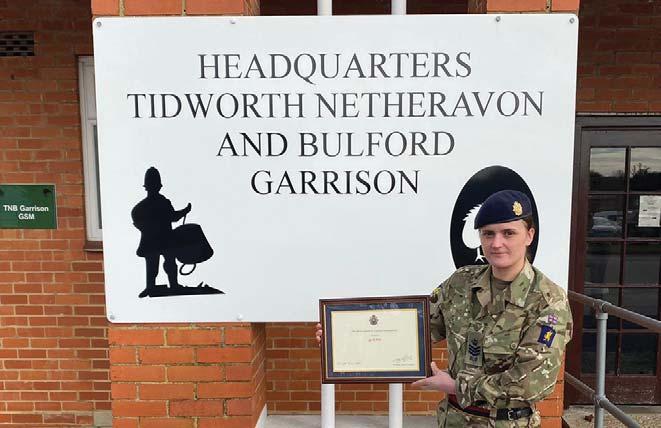
SSgt Kerry Bale, RLC Chef, Garrison Management Team, HQ Tidworth Netheravon and Bulford Garrison: “We are part of a family that has a shared determination and purpose to enhance the lived experience of our fellow soldiers. We do this with passion, pride and creativity. We always try to provide the highest level of nutrition and contributing to morale, regardless of the challenges we face.”
breakfast might be the last that solider eats, so I need to make sure it’s my best.’ In January, the trade set up a working group with the aim to understand what it is to be an RLC Chef and then deliver a tangible output that unites our values and gives us a common purpose, using the RLC strategy as a handrail. We needed to build the team from the bottom up and dispose of barriers such as rank, so that we had parity. Ultimately, rank holds the assumption that the one with the biggest badge has the best idea and the final say. In fact, this change will affect every member of the trade and it was essential to make sure that every member had an equal voice. Ideas flowed and the group identified outputs that could deliver the aim; a trade mission and vision and an ethos statement.
By having a joint mission and vision we are strategically focused as a trade in what we are currently delivering and how we can move forward collectively. Our ethos

Sgt Julie Robinson, RLC Chef, Instructor Food Services Training Wing: “Our Ethos highlights the high-performance culture, dynamic ability and persuasive influence that we have. It showcases our ‘growth mindset’ and how we work together, establishing our mutual values. It projects our passion, skills and professionalism, we are not just chefs we are a family. Our Ethos will help all RLC Chefs, instilling a culture and philosophy of belonging into our trade that will endure for years to come.”

WO2 William Grist, RLC Chef, 29 Royal Engineers: “The RLC Chef Ethos project was created with the vision to implement an ethos that allowed the RLC Chef to feel a sense of belonging. It was an opportunity to strengthen our identity and pride in order to maximise our talent, which would help create new ideas, empowerment and innovation for the future. The trade has seen a reduction in its workforce and changes in its role, however, this hasn’t stopped us being world class leaders in delivering culinary excellence, whether that be in the home base, on exercises or overseas operations. The ethos allows us to have an identity, understanding our importance and what we deliver now and for the future, instilling that excellence, professionalism and self-pride for the next generations of RLC Chef.”
shows the characteristics of an RLC Chef, the spirit that drives us to achieve our mission and how we can deliver the RLC vision in a trade context. This shapes our culture to become better leaders and problem solvers, with adaptive thought and an agile posture. It enables us to be a community, even if we are dispersed, because we all understand our expected behaviours. This is essential in building belonging and identity and is only the tip of the iceberg. Shaping our behaviours is a wicked problem and is linked with how society adapts. It requires constant review and challenge to remain current. However, it is a huge step in the right direction. This was a ground led project to solve a problem that was identified by a soldier. It has enabled innovative thought and shows that anyone can adopt The RLC strategy to create change. Not only this, it shows that The RLC is a progressive learning organisation that empowers its people to make significant change; fundamentally, walking the walk of its own strategy, placing people at the forefront of the organisation.
I am proud to lead this project, it has shown me that that if we work together, we can achieve fantastic results, challenge our own assumptions and break through organisational norms to create a brighter future.
We are a family, we thrive together… We are the Chefs!

Cpl Vicky Pimm, RLC Chef, RLC Nurture team: “Since joining the Army, we all have become well versed in CDRILLS and, most of us, practice them daily, sometimes subconsciously, as they have become ingrained into the process of decision making. Ultimately, we practice making the correct choices, even if they are not always the easiest, in order to become better leaders. Having a statement that we can all adopt, allows us to reach end goals and objectives, as a team, with full co-operation, support and guidance.”

Cpl Chris Moloney, RLC Chef, 1 RDG: “I am glad I was given the opportunity to take part of this project, I feel that I have helped to leave a massive stamp on the trade.”
The British Army Training Unit Kenya (BATUK) is the Centre of Excellence for Light Role Infantry Training, situated in Nanyuki, 150km north of Nairobi. BATUK’s focus is to plan, enable and execute Light Infantry Battle group and Combat Service Support (CSS) Group training exercises, the latter comprised of 102 Logistic Brigade sub-units, offering ample space to accommodate and prepare deployed troops to execute the Exercise ASKARI series.
When the SO3 CSS trawl at BATUK came across my desk, it will not surprise many that I leapt at the opportunity to deploy. While I am highly aware the SO3 CSS post in BATUK needs no advertisement, I hope this article instils an idea of opportunities to young officers across the Corps of what The RLC and the Field Army has to offer.
As the Logistic Department 2IC, the SO3 CSS post is the focal point for departmental operational and administrative outputs as well as encompassing the Troop Commander role for 30 permanent and temporary staff, spanning five RLC trades and 40 locally employed civilians. I have been exposed to a variety of situations, encompassing a range of trades that unless posted to some of our more niche regiments, many officers simply would not come across – at least not in the same posting. I have found Mission Command to be key. The WOs and SNCOs are critical as in any organisation to the smooth conduct of technical outputs; continuous liaison throughout the Chain of Command is critical, highlighting issues or concerns that may disrupt or prevent continued logistic support.
In 2022, there are plans to deploy the CSS Gp for the full duration of Exercise ASKARI STORM, to provide Logistic, Equipment Support, Provost Service and Medical support to the deployed Battlegroup. The training value for CSS elements in this sort of endeavour is immense. A clear progression from learning by ‘doing’ to learning by ‘training’; a combination allowing for real-life trade progression and green training within the challenging environments at Archer’s Post
SAFARI NJEMA BATUK
By Capt Mark Lewis-Taylor, SO3 Log Sp BATUK
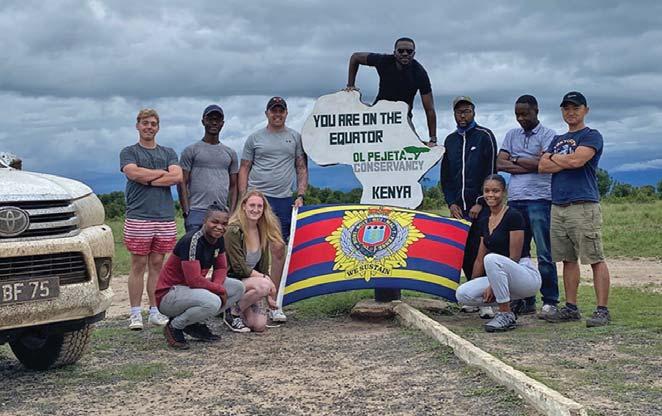
and Lolldaiga Training Areas. Consequently, the SO3 CSS role will straddle the CSS (Log) Dept and BATUK TacOps to support exercise planning, co-ordination and facilitation of the CSS Gp exercise program. In support of the recent Exercise ASKARI STORM, I was involved with the reception of deploying troops and freight on their arrival in Kenya and deployed to Mombasa for the semi-annual Maintenance Sail, working closely with the Movements’ WO and Mombasa Port Authority.
Aside from the daily operations of the department, I was fortunate to be the BATUK logistic representative in conceptual development for Exercise RHINO CHARGE, the outcome of the 102 Logistic Brigade End-To-End Study. Like Operation TRACTABLE, Exercise RHINO CHARGE is the multi-modal movement of vehicles, equipment and stores across Kenya, using a mixture of road and rail, military and civilian; clearly a challenge when incorporating the socio-political appetite, genuine Al-Shabab and criminal threat and infrastructural issues amongst a host of other external constraints and threats. The move will require interoperability between various Logistic Brigades, encompassing elements from at least five Corps.
As per BATUK Commander’s direction of exploiting the opportunities available in Kenya, the CSS Dept, through the work of previous permanent staff, are linked with the Imara International Orphanage who cater for under-18s who have previously experienced extreme hardship growing up. I’ve been fortunate to visit on several occasions with some of the RLC soldiers to assist where possible by putting on various activities. I also played cricket for BATUK against some local teams and at the prestigious Rhino Cup.
And finally, if the SO3 CSS role in BATUK needed any more selling points, Kenya boasts one of the widest arrays of wildlife. There are various wildlife conservancies including Maasai Mara and Lake Naivasha and of course Ol Pejeta, home to the last two Northern White Rhinos in the world.

8 Quad Biking in Samburu 8 Representing The RLC at the Ol Pejeta
Equator Sign

The RLC Museum collection is cared for by two teams of staff; the three-dimensional objects and framed images and documents are looked after by the curators and the archivists care for the documents, books, photographs and audio-visual archives.
While the old stores in the museum at Deepcut had some form of limited climate control, we had many problems with one of our off-site stores which was a converted garage on the main barracks. The building leaked regularly, the temperature was very difficult to control and it was also vulnerable to pests such as mice and rats.
The new museum store was built specifically to hold the museum’s collection and the staff were able to have an input into the conditions that would be required. We can control the temperature and humidity in this new store which is essential for keeping the collection in the best possible condition.
Many objects in the store are wrapped in acid-free tissue paper and then placed into boxes which keep the object in a stable micro-environment. Larger objects go straight onto the shelves lined with tissue paper or archival foam.
We also use our old medal display case to store our medals and some statues. We store flat unframed artwork in map drawers and we have a secure cage for our weapons, all of which are deactivated as required by law.
Most of the objects we have in the collection have been donated by the public, while a small number were purchased at auction. We are required by our Museum Accreditation standards overseen by the Arts Council England to ensure that before we take an object into the collection, we must be able to care for it properly and we must have adequate storage for it. We have so many duplicates of certain objects that we only accept new examples under exceptional conditions. Other objects we are actively collecting as we are underrepresented in those areas. These include objects relating to the Army Catering Corps, Royal Pioneer Corps and personal items from members of The RLC serving in more modern theatres of war.
When objects arrive in the collection they are quarantined. This is usually in the freezer, where they are wrapped in tissue and then sealed in a polythene bag at -38°C for a week and then slowly thawed, cleaned and vacuumed. After this, they are catalogued, photographed and put away until needed. Alongside the new permanent displays, we also have a program of temporary exhibition s which allow us to show more of our collection. We are also undertaking a digitisation project for our object collection where we hope to have an online searchable database linked from our website in early 2022.
Since the move to Worthy Down, we have started a new inventory to make sure that everything we own is in the correct location. We have a specialised Collections Management database where all our objects, archives and photographs are catalogued. This allows us to know exactly what we have in the collection and where it is. This was essential when designing the new museum as we knew we were going to put on display many objects which had not been shown before and interpret them and the stories attached to them.
Open the stores: A look into the preservation of the museum collection

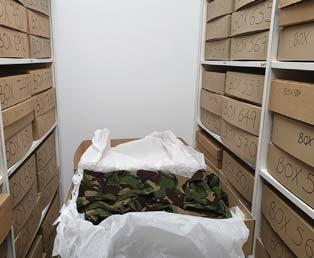
8 The temperature and
humidity-controlled store helps to keep the collection in the best condition
8 Objects are wrapped in acid-free tissue
paper and placed in boxes to keep them in a stable micro-environment
The RLC Horse-Drawn Heritage
By Major Alison Shaw
The RLC Horse-Drawn Heritage (H-DH) Team don’t need to be asked twice to ride out and display their green fleet of WW1 vehicles, so when The RLC Museum at Worthy Down agreed to support the team and asked them to parade a MK X GS wagon at the launch of the Museum on 17 May, the team naturally jumped at the chance.
Our H-DH vehicles are now stored and displayed at the museum, which provides safe, dry and clean conditions to house the vehicles. However, after years of display events and transporting them from and then back into Deepcut Barracks, they had been looking a little the worse for wear and so, with the arrival of a new permanent home, the decision was taken to carry out some renovation work on the MK X GS Wagons and the Mk II Horse Ambulance. After much planning and a fair amount of logistics, the vehicles were transported to 7 Aviation Support Battalion REME’s MT department at the Army Flying Station, Wattisham, Suffolk.
With encouragement from everyone in the department, team member LCpl Craig Salt then set about overseeing and carrying out the work to be done. The vehicles were stripped down as much as possible, with all brass and leather being removed for cleaning and treatment. All of the stripped-down parts and the main structures of the wagons were sanded down to remove multiple previous paint layers wherever possible and a fresh undercoat was applied where needed with each wagon having two or three coats of fresh paint. A quality green paint of the correct colour was sourced and purchased with all vehicles using the same shade for period uniformity. Interestingly, what we routinely know as ‘Drab Green’ is called Tarragon Glory in the civilian world.
Some metal work was also stripped and cleaned in an oil bath before reassembly, repairs were carried out where necessary i.e. some ambulance legs needed high pressure compression to straighten them so they would be functional again. LCpl Salt carried out most of the work, but was ably assisted by the staff on site when heavy lifting was required. The Motor Transport Warrant Officer (MTWO) and SSgt changed wheels on a wagon, remarking it’s not often they do that on a 1914 vehicle! The interest shown and support from everyone at the Station was invaluable and very much appreciated.
Our vehicles came back to the museum looking almost as good as the day they were first made over a century ago, being positioned either in the museum itself or outside at the front for visitors to walk around and admire at the launch event. The museum had been officially opened the previous week by HRH the Princess Royal and the museum launch event was for a selected guest list due to COVID restrictions. Our trusty pair of regularly hired-in horses, Willy and Wiggie, were on fine form as they were harnessed into one of our Mk X GS wagons and driven round Worthy Down Barracks before arriving at the front of The RLC Museum to mark the start of the day's proceedings.
Sgt Tony Bysouth and LCpl Craig Salt were in authentic WW1 period uniform as they drove the wagon and answered many questions from Hampshire’s Lord Lieutenant, Colonel Jon West - the Corps Colonel and interested guests. They even featured on Forces News and the local BBC and ITV News programmes. Everyone agreed that the horse-drawn wagon and period drivers were an excellent addition to the day and a fitting addition to the new museum that encompasses the history of logistics from mules to motors.
Do come along to the museum to learn more about our interesting mix of WW1 Horse-Drawn Heritage green fleet vehicles and if you’re interested in joining the team, we’re looking for more volunteers.
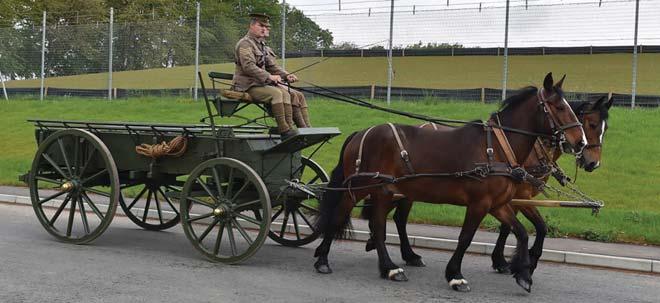
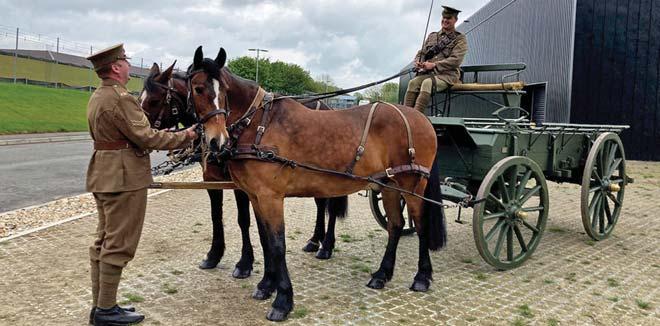
8 Sgt Tony Bysouth and LCpl Craig Salt
driving the wagon around Worthy Down Barracks
8 Willy and Wiggie harnessed into the
Mk X GS wagon
The Royal Logistic Corps Foundation exists to foster the relationship between The RLC, industry and academia; sharing best practice, knowledge and mutual understanding amongst logistics professionals.
Exercise LOG SAFARI took place on the Bicester training area on 5 Aug 21. This was an opportunity for RLC Foundation members to engage with serving RLC officers and soldiers to discuss first hand, how their trade skills fit together within an operational environment. This display of operational capability showcased supply and distribution, ammunition technical services, food services, fuel and petroleum operations, air despatch, port and maritime and postal and courier operations. Foundation members were encouraged to take part in the numerous ‘hands-on’ trade stand demonstrations and this interactivity was very much enjoyed by the members. It was an excellent day all round the Foundation is very grateful for all the hard work put into this event by the organisers and the participating units.
On 9 Sep 21, World Fuel Services (WFS) hosted a joint industry and military operational capability event at RAF Northolt. The morning session consisted of a series of presentations from WFS and RLC Petroleum Operators. These presentations focused on the Defence Fuels Management System, WFS Resilience and Technical Services and their inherent risks. In the afternoon, attendees visited a practical display on a whole range of refuelling operations featuring the Deployable Bulk Fuel Installation, truck refuelling, compliance fuel testing and quality assurance. Over 50 delegates attended and the Foundation would like to say a big thank you to WFS for hosting this excellent event.
Dates for the diary: 8 30 Sep 21 – Military planning event hosted by 13 AASR at
Colchester 8 Oct (date tbc) – TVS Supply
Chain Solutions ‘Transition’ event for service leavers 8 03 Nov – RLC Foundation
Awards Dinner at 29 Regt RLC
The RLC Foundation

Foundation contact details: Director: Alan Woods rlcfwoods@gmail.com Business Support Manager: Chrissie Ross therlcfoundation@gmail.com Follow us on Linkedin and Facebook by searching for Royal Logistic Corps Foundation or visit our website: www.rlcfoundation.com

Book review A Great Feat of Improvisation: Logistics and the British Expeditionary Force in France 1939-1940. Clem Maginniss. Publisher: Helion Company, 2021. Written by an ex-RLC officer, this well researched labour of love addresses not only the historic logistic void in the British Expeditionary Force’s operations, but also opens a broader analysis of the evolution of Britain’s land power sustainment in WW2 and beyond. Published as a series of well written essays, selective components of logistics are used to demonstrate their direct 8 A group of RLC Foundation
members at Ex LOG SAFARI
relationship to combat operations. This relationship is revealed through a series of constraints that logistics imparted on operations, but also the freedoms it offered if considered at an early stage. For readers following the contemporary debate surrounding the implementation of the Integrated Review and its associated Command Paper, there is much in this publication which demonstrates that at least conceptually, there is not a lot that is new under the logistic sun. Maginniss emphasises that even when the British Army was in its mechanised infancy, it started struggling with reducing the size and scope of administration and monopolizing the provision of air transport to enable urgent support to small armoured forces (pp.6061) in an attempt to cut the administrative umbilical cord (p.62). These military desirables were all focused on, successfully supporting mobile operations in a dynamic ground and air environment (p.63) – these phrases will no doubt sound familiar with those grappling with future logistic laydowns in support of the UK’s global defence aspirations. The author’s sources and referencing are excellent and offer any military logistician a wealth of information on doctrinal development, manufacturing challenges and the difficulties of fielding and supporting a land force across a broad spectrum of operations. This book is well worth the full cover price and will be a strong contender for inclusion in MGL’s Professional Reading List.









